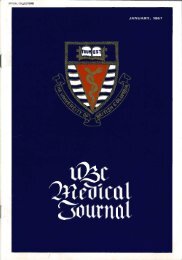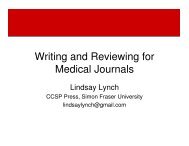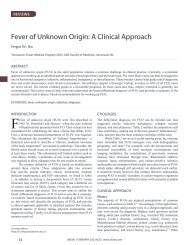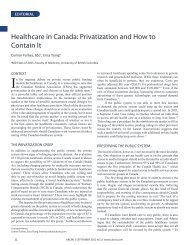Download full PDF - UBC Medical Journal
Download full PDF - UBC Medical Journal
Download full PDF - UBC Medical Journal
You also want an ePaper? Increase the reach of your titles
YUMPU automatically turns print PDFs into web optimized ePapers that Google loves.
YEAR 2<br />
British Columbia (<strong>UBC</strong>) medical students participate in family<br />
practice office visits. Working with preceptors, students are<br />
exposed to a wide variety of clinical practice guidelines and<br />
common conditions. To assist the students with office visits, family<br />
medicine departments across Canada have created pocket cards<br />
and information sheets related to common medical topics. This<br />
project aimed to enhance <strong>UBC</strong> student experiences at preceptor<br />
offices by creating a reference booklet of the most common<br />
diagnoses in family practice. To identify booklet content, a focus<br />
group and literature review were conducted. The focus group was<br />
comprised of nine first-year <strong>UBC</strong> medical students and held in<br />
June 2009. Based on their own preceptor office visits, students<br />
identified the usefulness of including basic clinical guidelines<br />
(ex. immunization schedules, maternity guidelines) in addition to<br />
common diagnoses. A literature search failed to solidify a ranking<br />
list of diagnoses so a list of seven common patient complaints was<br />
constructed using focus group feedback, literature, the Canadian<br />
Shared Family Medicine Curriculum Core Objectives list and<br />
second year rural rotation data. Booklet information was gathered<br />
from curriculum resources, guideline authors and medical<br />
literature. The final product, “Quick Reference Pocket Guide to<br />
Preceptor Visits,” was distributed to first and second year medical<br />
students in Fall 2009. The pocket guide contains basic clinic<br />
tools (ex. comprehensive history template, Rourke Records)<br />
and seven common patient complaints that students will likely<br />
encounter in preceptor offices. Differential diagnoses, focused<br />
history questions, and clinical information (definition, etiology,<br />
pathophysiology, signs and symptoms) for select diagnoses are<br />
provided for each complaint. Next steps for the guide include a yearend<br />
student evaluation and potential revisions based on feedback.<br />
Implementing a sustainable health<br />
education curriculum for children of<br />
a remote community in the Indian<br />
Himalayas<br />
Elizabeth Hendren BSc 3 , Sanja Brkanovic BSc RD 1 ,<br />
Laura Chng BSc MPH 2 , Karen Giang BSc 2 , Ada Lam<br />
MSc 2 , Tyler Ngai BSc 2 , Simon Rose BASc PEng 2 , Michael<br />
Suen BSc(Hons) 2 , Steven Skitch PhD 2 , Natalie Taha<br />
BHk 2 , Gavin Tansley 2 , Luke Bornn 3 , Videsh Kapoor MD 4<br />
1<br />
Faculty of Land and Food Systems, University of British Columbia<br />
2<br />
Faculty of Medicine, University of British Columbia<br />
3<br />
Faculty of Science, University of British Columbia<br />
4<br />
Department of Statistics, University of British Columbia<br />
5<br />
Department of Family Practice, Faculty of Medicine, University<br />
of British Columbia<br />
Background: <strong>UBC</strong> Global Health Initiative (GHI) is a student<br />
led group that has run health projects through a remote boarding<br />
school in the Indian Himalayas since 2007. In the past, the<br />
community approached GHI requesting a health curriculum<br />
to encourage practical applications of basic hygiene and health<br />
knowledge. In 2009, a sustainable curriculum was developed<br />
which built upon existing health initiatives in the community.<br />
Methods: GHI students oversaw the design and implementation<br />
of the health curriculum, which included lessons on hand washing,<br />
skin and oral hygiene, tobacco, and water. This required the<br />
identification of major health issues through health screens and<br />
observation along with collaboration with school and community<br />
leaders. Teaching materials (posters and lesson outlines) were<br />
provided to teachers and GHI students taught lessons from<br />
this curriculum. Sustainability was incorporated through the<br />
formation of a teaching partnership with local nursing students<br />
and engagement of senior students.<br />
Results: In 2009, 420 students were provided lessons from the<br />
curriculum. Success has been measured by changes in hygiene,<br />
specifically an increase in frequency of hand washing and wound<br />
cleaning, and the use of more appropriate drinking water sources.<br />
By involving teachers, senior students and nursing students, GHI<br />
has empowered the community to take a more active role in health<br />
education. With a successful program in place, the school can<br />
act as a model for change for other schools in the Spiti Valley;<br />
additionally students can continue to build healthy habits long<br />
after GHI has left the community.<br />
Legal Needs in Adult Survivors of<br />
Paediatric Malignancies<br />
Gabriel Hung 2 , Robert Olson 1,2,3 , Mary Ann Bobinski 2 ,<br />
Karen Goddard 1,2<br />
1<br />
BC Cancer Agency<br />
2<br />
Faculty of Medicine, University of British Columbia<br />
3<br />
Harvard School of Public Health<br />
Background: This study analyzes the efficacy of the BC Cancer<br />
Agency (BCCA) Late Effects Clinic for adult survivors of<br />
childhood cancers and the need for a legal resource center.<br />
Methods: 77 adult survivors were approached with a mean age of<br />
7.5 (SD 4.7) and 31.8 (SD 7.0) at the time of primary diagnosis<br />
and survey completion, respectively.<br />
Results: 76 (98.7%) of respondents completed the survey. Central<br />
nervous system (CNS) tumors were the most common malignancy<br />
(34.2%), followed by leukemia (31.6%), sarcoma (15.8%), and<br />
lymphoma (11.8%). Legal problems were common overall<br />
(38.1%), though more prevalent in those with CNS versus non-<br />
CNS tumors (59.1% vs. 26.8%; p = 0.016). 93.3% of individuals<br />
with legal problems found it difficult to find legal help. Overall,<br />
83.6% of respondents indicated it would be beneficial to have a<br />
legal help resource. In terms of care provided, 97.3% of survivors<br />
indicated that follow up at the BCCA had been beneficial. Family<br />
doctors were seen more frequently by CNS versus non CNS<br />
tumors survivors, (6.21 vs. 4.6; p = 0.357) though this was not<br />
statistically significant. The majority of patients (92%) preferred<br />
to be followed by BCCA and their family doctor.<br />
Conclusions: These results suggest that a legal resource center<br />
would likely be beneficial for childhood cancer survivors<br />
(especially those with CNS tumors) due to their increased<br />
encounters with legal difficulties. Different ways to improve<br />
communication and co-ordinate patient care with family doctors<br />
should be further explored.<br />
<strong>UBC</strong>MJ | APRIL 2010 1(2) | www.ubcmj.com 6










